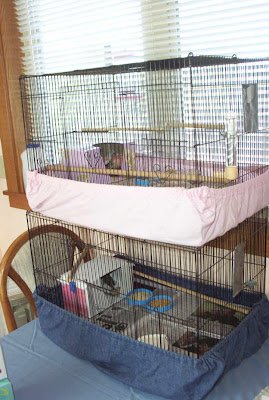Hand feeding young Bourke parakeets. Each time they are fed I change their diapers, moving them from a dirty box to a clean one. In the photo below, they are leaving the green box and will go into the pink one that has a new paper towel on the floor. I use a lot of paper towels, as you can see. I also use tissues dipped in warm water to wipe their faces clean after a feeding.
Each tissue box has a layer of pine shavings under a folded paper towel. They're absorbent. Before each feeding, when the paper towel is soiled, it's removed. I tilt the box so that the pine shavings lay in the back and off the bottom of the box. If the box floor became damp it will dry out before the next feeding. Tilting the box to move the pine shavings allows them to dry also. When it's time to feed again, I prepare the box before the hand feeding formula so that it is ready for the birds after they are fed.
 |
| Tissue box with clean pine shavings, ready for a paper towel to lay over them creating an absorbent floor for the box. |
The Gouldian finches have been moved from their incubator and into a cage. They haven't flown yet, but are stretching and flapping their wings. In the photo below they are in the bottom cage with the two Bourke parakeets above them.
I keep my hand fed babies in the kitchen. It's the most convenient place, near the microwave for heating water. Also, a sink for cleaning bowl and eyedropper after every feeding. By allowing the cages to sit on a corner of the kitchen table, they're near us when we eat. That encourages them to try to eat on their own. It also helps to familiarize them with our activities and keep them calm.
 |
| A closer view of the Gouldian babies' cage and box. Easy-to-eat food is present: spray millet, nestling food, finch seed and a low bowl of water. Low perches too. |
Hand feeding a parrot or macaw is probably lucrative, but for these little guys it really isn't. It's very time consuming and more costly than those fed by their parents, both in items used and time spent. Whatever the hand fed babies sell for, it doesn't make up for the cost and time involved. Parent fed parakeets are a more practical endeavor. I do it for love, and so I can have some very tame birds of my own.
Peace and Blessings!




No comments:
Post a Comment